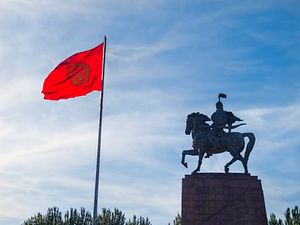Friday links:
Deported from Kyrgyzstan for Horse Penis Joke: A British employee of Centerra Gold was ordered to leave Kyrgyzstan after his New Year’s Facebook post comparing chuchuk — a sausage made from horse meat — to a “horse’s penis” touched off a strike at the mine on December 2 and ire from local Kyrgyz. While it may seem absurd to deport someone for such a comment, as RFE/RL’s Kyrgyz service noted it couldn’t have come at a worse time, PR-wise, for Centerra Gold. The Canadian company is in the midst of a years-long struggle with the Kyrgyz government about the ownership and operation of the crucial gold mine and offending the local cuisine probably doesn’t help its brand name much. But, as Bektour Iskender, the founder of Kyrgyz news website Kloop.kg, wrote (translated by Eurasianet) the issue goes deeper:
At the root of the story is a profound problem, and that is the fundamental lack of mutual understanding between Kyrgyz- and Russian-speaking sections of the population.
As it happens, the original Facebook posting itself quickly ceased to be the center of attention among Kyrgyz people. Discussion turned from the ill-judged remarks by Centerra employee Michael Mcfeat into a heated debate about Kyrgyz identity and the extent to which it is permissible to mock that identity.
Other must reads on Kyrgyzstan: Claire Provost and Ryskeldi Satke have an exhaustive piece on The Guardian diving into tensions surrounding the Kumtor mine between environmental activists concerned, the powerful international bodies backing the mine, and the authorities wary of protests. Also check out Eurasianet’s discussion on the link between a slowdown in housing construction and currency troubles in the country.
Tajikistan, Iran and Saudi Arabia: In late December 2015, exiled IRPT leader Muhiddin Kabiri appeared in Iran at a conference seated alongside representatives from Tajikistan, where he’s been labeled a terrorist. Tajikistan summoned the Iranian ambassador for a reprimand and expressed in no uncertain terms its disapproval of Iran’s seemingly warm embrace of Kabiri. So when Tajik President Emomali Rahmon traveled to Riyadh in early January eyebrows were raised (and not just because of Rahmon’s flimsy white robe and nip-slip). That Rahmon was in Saudi Arabia when it cut diplomatic ties with Iran added to the feeling of a split. Tajikistan shares cultural and linguistic roots with Iran that have formed the basis of a decent relationship. Similarly, Tajikistan has kept cordial ties with Saudi Arabia. As Eurasianet notes, the awkward thing is that Rahmon’s government has pursued a sustained crackdown on Islam. One example of cognitive dissonance at play:
Rahmon has said in broadcast remarks that women adopting the hijab — like the one worn by his wife and daughters in Mecca for instance — were “lost” and should be taken to task.
Other Tajikistan reads: Part of Tajik government’s pursuit of Kabiri has involved hounding those linked to him, like Tajik journalist Haramgul Qodir who submitted to a virginity test to prove that while she was in “love” with Kabiri, she did not have an affair with him. Also, though not specifically about Tajikistan this paper on remittances and Dutch disease by Igor Eromenko and published by George Washington University’s Central Asia Program is worth checking out given the countrys’ dependence on remittances (which I discussed earlier this week). Dutch disease, a term which refers to the resource curse (itself often meaning dependence on exports of oil and gas) can also point to dependence on inflows, like remittances or foreign aid.
How About that Silk Road: While the phrase “silk road” was in the running for my two phrases to be banned from Central Asia coverage governments are intent on using it, so we writers are strung along too. Wade Shepard has a new article up this week about the Western Europe-Western China (WE-WC) Corridor, “or, more romantically, the New Silk Highway.” The rehabilitation of old roads and construction of new ones are the physical evidence that China is intent on reviving the old Silk Road.

































